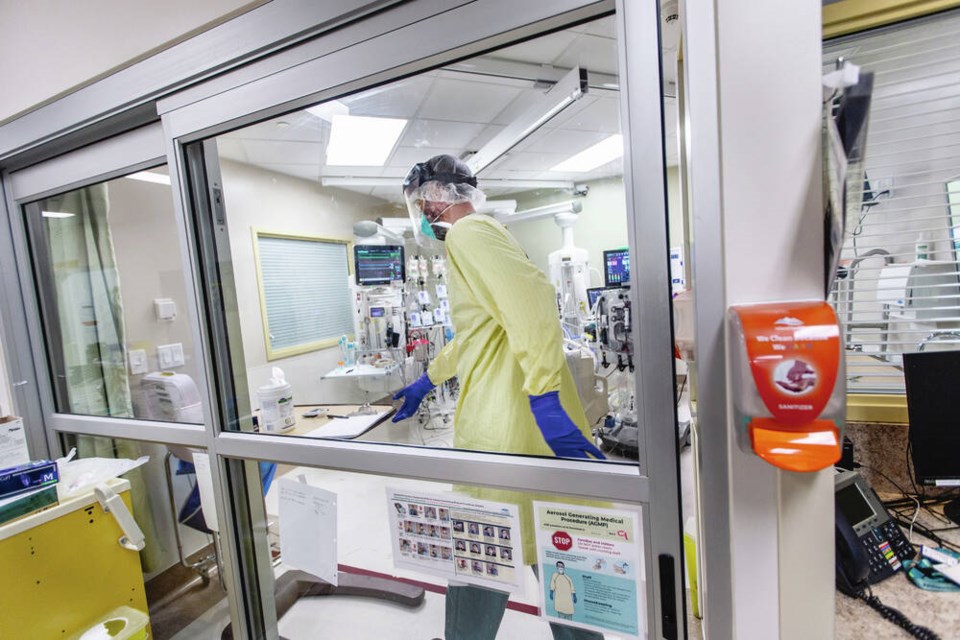Hospitalizations have plummeted in the past six weeks but deaths — which spiked alongside an explosion in COVID-19 case counts with the new Omicron variant — remain at their highest level since the second wave in the fall of 2020.
But experts expect the death tally, which has started to trend downward slightly, to fall as hospitalizations and case counts do.
“We would expect hospitalizations and deaths to lag the decrease [in infections], especially deaths,” said Simon Fraser University epidemiologist Caroline Colijn, a Canada 150 research chair in mathematics for evolution, infection and public health.
Added Dr. Brian Conway, president and medical director of the Vancouver Infectious Diseases Centre: “Death is the ultimate lagging indicator. It’s a thing that goes down last after everything else.”
Weekly hospitalizations peaked six weeks ago, at about the 750 level, and have dropped to the 200 level, according to provincial health figures.
The week ending Friday, Feb. 25, the latest date for which statistics are available, there were 53 deaths from COVID-19, bringing the total to 2,903.
The weekly toll is down from two weeks earlier, when, for three weeks, deaths were in the 70 to 80 range.
Still, the numbers are not as high as they were in the fall of 2020, when vaccines were not yet available, when as many as 100 people a week died.
Statistics from the B.C. Centre for Disease Control show that those who are dying in the surge of the highly transmissible Omicron variant are in the oldest age groups, the majority of those 80 years and older.
In a briefing last week, B.C. health officials also noted that 47 per cent of those with COVID-19 in intensive care are people who are not vaccinated, even though the unvaccinated represents eight per cent of the population.
University of B.C. epidemiologist Dan Coombs noted the median age of death during the pandemic has remained solidly in the low 80-year-old range.
“What it’s basically telling you is that there’s a group of people out there who are highly vulnerable,” said Coombs, who has expertise in mathematical models of pandemic growth and control.
“It should improve for those people because as the amount of circulating virus drops, the likelihood of them getting infected will also drop.”
Despite the recent spike in deaths from the Omicron surge, British Columbia has fared better than other provinces.
B.C.’s cumulative COVID-19 death rate is lower than for other populous provinces, including Quebec, Ontario, Manitoba, Saskatchewan and Alberta.
B.C. also has fared better than some other global jurisdictions.
Its COVID-19 death rate, at 600 per one million people, is much lower than in the U.S., at 2,894, or the United Kingdom at 2,423, according to figures compiled by Statista.
Across the U.S. border, in Washington state, the cumulative death rate is 1,600 per one million people, nearly triple B.C.’s death rate.
While hospitalizations drop and deaths trend downward, B.C. health officials are examining when they might remove the remaining restrictions that include a requirement to wear masks in all indoor public spaces, including for students in school. In B.C. you must also show a so-called vaccine passport, which provides proof of full vaccination, to get into non-essential public venues such as restaurants, bars, movie theatres and sports arenas.
B.C. has moved more cautiously than some other provinces such as Alberta, which recently lifted most mask mandates and removed vaccine passport requirements last month.
“We will be removing restrictions and layers of protection as soon as we are confident we can safely make those changes,” provincial health officer Dr. Bonnie Henry said last week.
Experts said they expected the province to look soon at lifting the remaining restrictions, but had no issue with the province moving cautiously.
Coombs said even when mask mandates are removed, he expected to see some people continue to wear them, particularly on public transport or in movie theatres.
Colijn said as restrictions are removed, it will be important to keep up a surveillance program of the coronavirus as it will continue to mutate and new variants will emerge.



